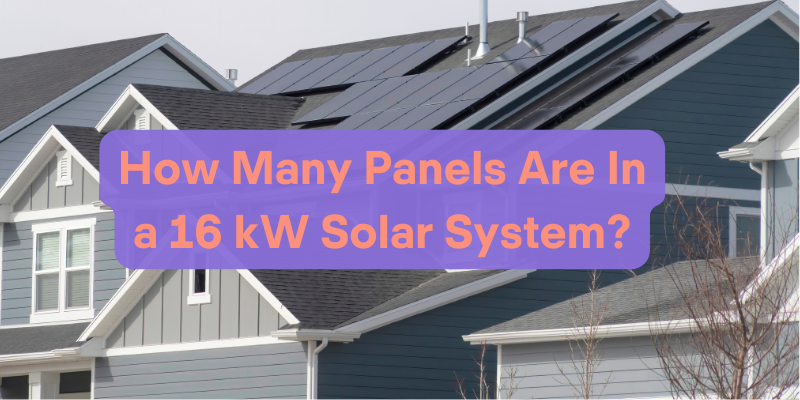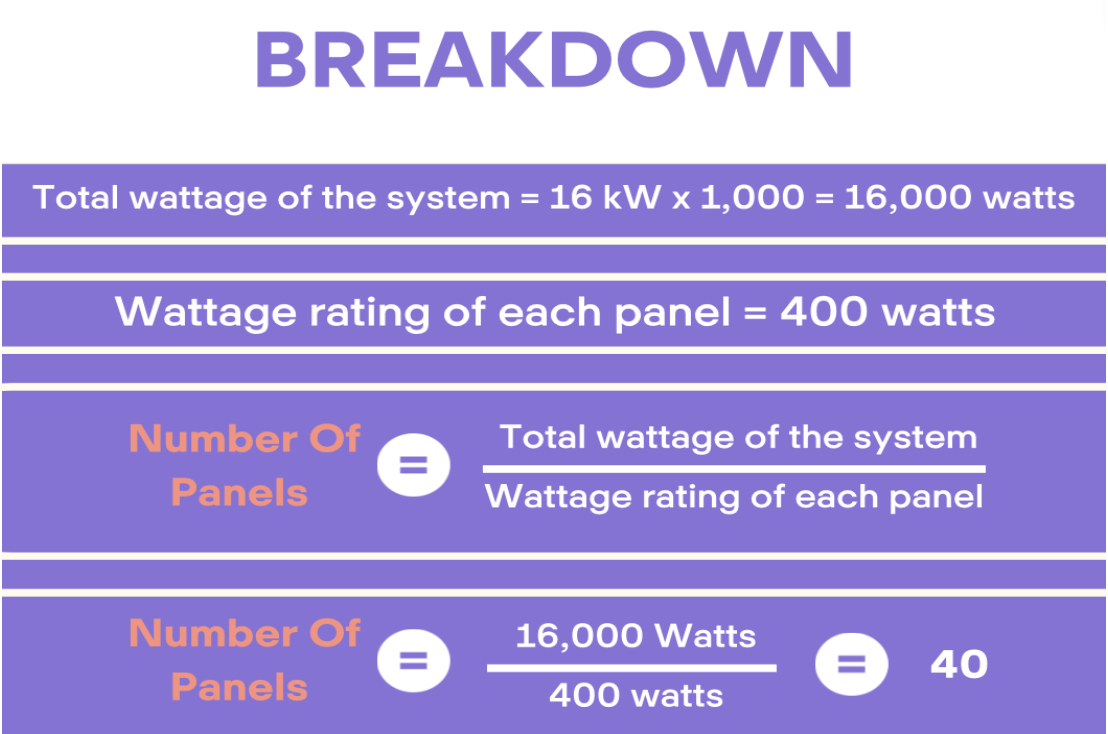
There’s something exciting about putting a nice round number on the amount of solar panels you need. The number of kilowatts in a solar system doesn’t mean much to most people, but the number of panels on a roof paints a vivid picture.
16 kW is a rather large solar system, but entirely feasible for a household with high electricity consumption and an EV or two charging in the garage. And the more electricity you’re using at home, the more you can save by going solar.
So if you yourself find yourself looking for that sweet sixteen, here’s how to find out how many panels you need, how much electricity you can expect them to produce, and a ballpark cost for the solar panels and installation.
How many panels are in a 16 kW system?
There are typically 40 solar panels in a 16 kW solar system with a power rating of 400 Watts each. However, this number can vary depending between 35 and 50 on the power rating of each panel.
To determine the number of panels in a 16 kW (kilowatt) solar system, we need to consider the wattage rating of the individual solar panels. This “nameplate” rating signifies the maximum power the panel can produce in ideal conditions.
Assuming each solar panel has a wattage rating of 400 watts (by far the most popular power rating on the solar.com marketplace), we can calculate the number of panels needed in a 16 kW (16,000 Watt) solar system as follows.
System size (Watts) / panel rating (Watts) = Number of panels
Using this equation, we find that it takes 40 solar panels with a rating of 400 Watts each to make up a 16 kW solar system.

Whether you are looking for a 16 kW system, or a 6 kW system you can apply the same method to determine the number of panels needed to meet your production needs.
How much electricity can a 16 kW solar system produce?
A 16 kW solar system can be expected to produce between 62-85 kWh per day in its first year, depending on how much sunlight it gets per day and energy lost during the conversion from DC to AC electricity.
In northern states like New York that average ~4 peak sun hours per day, a 16 kW system would produce closer to 62 kWh per day in its first year (assuming 2% conversion loss). In California and sunny southern states with closer to 5.5 peak sun hours per day, production should be slightly over 85 kWh per day.

To put that in perspective, running an average central air conditioning unit running nonstop for 24 straight hours would consume around 80 kWh, so 66-90 kWh is quite a bit of electricity per day.
To calculate expected production, start by taking the system size (16 kW) and multiplying it by the average peak sun hours for your location (shown in the map above).
16 kW × 4 hours per day = 64 kWh per day
Then, subtract 2% of the total DC production to account for efficiency loss when converting to AC electricity that is used in your home.
64 kWh – 1.28 kWh = 62.72 kWh per day
It’s worth noting that solar panels slowly decline in performance over time through a natural process called degradation. Most modern panels come with performance warranties that guarantee that they will be able to produce 85-92% of their original nameplate output after 25 years.
So, your 16 kW solar panel system will produce slightly less energy each year, but it’s normal and can be accounted for.
How much does a 16 kW solar system cost?
A 16 kW solar system typically costs between $56,000 and $64,000 before incentives, depending on your location, installer, equipment, financing method, and complexity of the project. Claiming the 30% federal solar tax credit would reduce the net cost to between $39,000 and $45,000.
Is that a lot of money? Yes. But does that mean a 16 kW solar system is expensive? Not compared to grid electricity. In fact, larger solar systems typically deliver greater overall savings because they come at a lower Price Per Watt (PPW) and offset more utility electricity costs.
Let’s say you live in New York and you use, on average, 63 kWh of electricity per day. The chart below shows the cumulative cost of buying a 16 kW solar system to produce that electricity versus purchasing that electricity from a utility provider.

Over 20 years, we can expect a 16 kW system in New York to produce ~380,000 kWh of electricity. Purchasing that electricity from a utility at the state average rate would cost nearly $108,000, assuming average annual rate hikes of 3% per year.
Factoring in New York’s monthly net metering fee:
- If you buy a 16 kW solar system with cash, you would pay around $46,000 for the 380,000 kWh of electricity
- If you purchase a 16 kW solar system with a 20-year loan, your all-in cost is closer to $68,000 dollars with interest, but your monthly solar payments are less than your average utility bill on Day 1
Compared to $108,000 for grid electricity, $46,000-$68,000 for a 16 kW solar system doesn’t sound so bad… and we used pretty conservative pricing for this example.
Bottom Line
16 kW is considered a fairly large solar system. But when properly sized and installed, bigger solar systems typically provide more bang for your buck than smaller systems.
The key to maximum bill savings and emissions reductions – for any size solar system – is to work with a reputable installer that will do the job right the first time and provide excellent customer service in the off-chance that issues arise.
Click here to compare quotes from solar.com’s network of reputable local installers.



